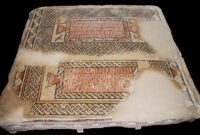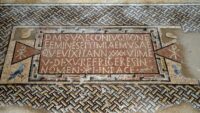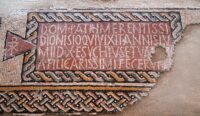 A funerary mosaic dedicated to a Roman couple of late Antiquity is returning to its museum home in Porto Torres, Sardegna, after more than a year of restoration.
A funerary mosaic dedicated to a Roman couple of late Antiquity is returning to its museum home in Porto Torres, Sardegna, after more than a year of restoration.
The mosaic was discovered in 1964 when road construction unearthed a complex of 11 Late Roman burials. Most of them were in rock-cut graves covered with terracotta roof tools arranged either flat or in the cappucina style, ie, tilted against each other to form a pitched roof. Eight of the burials were closely grouped together in a confined space, including the burials of two individuals whose matching pitched-roof tombs were adjacent to each other. A polychrome mosaic inscription identified the deceased as married couple Dionisio and Septimia Musa.
The osteological remains were in poor condition and had been disturbed over the centuries. There were no grave goods to aid in dating, but the cappucina style was very widespread in the popular in the Late Roman Imperial era. Funerary mosaics comparable in style to Dionisio and Septimia Musa’s, found most often in Northern Africa, and the language of the dedication narrow down the date of the tombs to the second half of the 4th century or to the early 5th.
 The mosaic featured two inscriptions of cream tiles against a rectangular field of red tiles to give the impression of an engraved plaque. Septimia Musa’s inscription is above her husbands. It records that she lived 47 years. Dionisio’s inscription includes the dedication from their “loving children.” Hers is bordered in a 3D gemetric rectangle. His is bordered in guilloche shapes. A more intricately enlaced guilloche pattern covers the background behind the plaques. The outer borders feature a curling ribbon pattern.
The mosaic featured two inscriptions of cream tiles against a rectangular field of red tiles to give the impression of an engraved plaque. Septimia Musa’s inscription is above her husbands. It records that she lived 47 years. Dionisio’s inscription includes the dedication from their “loving children.” Hers is bordered in a 3D gemetric rectangle. His is bordered in guilloche shapes. A more intricately enlaced guilloche pattern covers the background behind the plaques. The outer borders feature a curling ribbon pattern.
 The mosaic is rich in Christian iconography. Both plaques have triangular faux mounts on each side featuring the Christogram. Septimia Musa’s inscription has another Christogram in the RIP text at the end, as well as an olive branch. Olive branches are above and doves beneath the Christograms in the left and right triangles.
The mosaic is rich in Christian iconography. Both plaques have triangular faux mounts on each side featuring the Christogram. Septimia Musa’s inscription has another Christogram in the RIP text at the end, as well as an olive branch. Olive branches are above and doves beneath the Christograms in the left and right triangles.
The mosaic was lifted, conserved and put on display at the Antiquarium Turritano Porto Torres, the local museum dedicated to the material culture of the colony of Roman Turris Libisonis and the surrounding territory. In the six decades since, the mosaic tiles have begun to suffer from adherence problems. It was removed from display in September 2020 and conservators worked to stabilize and clean it until March of this year.
The museum will be closed on Tuesday to ensure the transfer and reinstallation of the mosaics goes as smoothly as possible. The mosaic will have to be reassembled, positioned and fixed securely in its dedicated gallery at the Antiquarium Turritano before the museum reopens to the public on Wednesday.